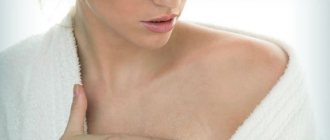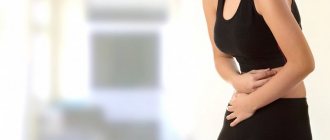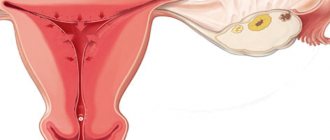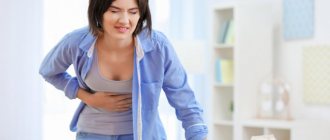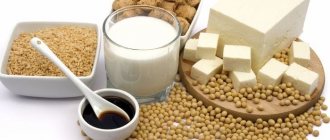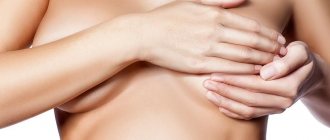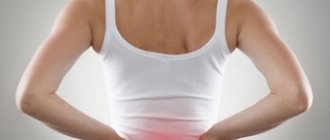Every second woman knows how her breasts hurt after ovulation. Breast pain is scientifically called mastalgia. It occurs in the second half of the menstrual cycle, when the mammary glands increase in volume due to swelling of the glandular tissue. The pain intensifies with movement, the breasts become dense, the nipples are more sensitive and also painful. The connection of these symptoms with the menstrual cycle is not accidental. It is after ovulation that the influence of progesterone, a hormone that is designed to promote pregnancy and its maintenance, increases in a woman’s body. This is how the body prepares for pregnancy in advance, but if conception does not occur, then reverse (involutive) processes occur in the target organs (uterus, mammary glands).
Breast pain after ovulation
More than 80% of women experience breast pain after ovulation. Pain can be of varying intensity, and it depends on the individual characteristics of the body. One half of the female sex eliminates discomfort only with the help of strong painkillers, while the other half does not feel any discomfort.
Normally, pain after ovulation goes away after 3-4 days. A signal of a pathological process is prolonged (more than 4 days) severe chest pain, accompanied by other unpleasant sensations:
- general malaise
- headache
- discomfort in the lower abdomen
- nausea
The presence of the above symptoms is a reason to consult your doctor.
Nature of pain
The nature of pain in the mammary glands after ovulation may vary. The mammary glands can be sensitive to any type of irritant (thermal and mechanical). If the painful sensations do not change in intensity for several months, and the attending physician has not identified any abnormalities in the body, then there is no reason to worry.
The nature of the pain can be expressed by the following conditions:
- hypersensitivity of the nipples from mechanical influences
- female breast enlargement
- aching pain during exercise
- short-term tingling in the mammary glands
Depending on the characteristics of the female body, lifestyle and the presence of systemic diseases, pain can be either difficult to bear or very weak. For some representatives of the fairer sex, discomfort in the chest area lasts no more than 2-3 hours. It must be remembered that when assessing the nature of pain and the condition of the whole body, previous ovulation processes are taken into account and in cases of suspicious signs it is recommended to consult a doctor.
How many days after ovulation do your breasts hurt?
In the absence of endocrine disorders and other diseases of the body, postovulation pain lasts no more than 3 days. There are also cases when unpleasant sensations accompany the beginning of the process of releasing the egg, thus the painful period increases to 5-6 days.
To prevent the development of serious pathologies, every woman should know the approximate day when the egg begins to leave the ovaries. To determine the ovulation period, there are many test strips. The occurrence of sensations unusual for ovulation, as well as an increase in painful days, are grounds for a visit to the gynecologist.
How to relieve pain
If a woman feels that she has pain in her chest and is sure that the nature of its appearance does not have any pathological disorders, she can use known methods to improve her condition. The most effective of them:
- Massage of the mammary glands helps normalize blood circulation. To do this, make several circular movements with your palm.
- Taking hormonal contraceptives will help normalize hormonal levels and relieve pain.
- The use of magnesium, vitamin E and primrose oil helps a lot. Before using any medications, consultation with a specialist is necessary, especially when planning pregnancy.
- The use of painkillers and ointments leads to the fact that the pain will stop for a while, but they do not eliminate the main cause of its occurrence.
- It is necessary to wear comfortable underwear, or avoid it altogether. It is necessary to provide rest to the body and not engage in heavy physical labor.
The causes of breast pain in the middle of the cycle can be various factors. Each woman’s body is individual, so you should visit a specialist to determine the nature of the pain. After a full examination, he will establish the correct diagnosis and prescribe individual treatment.
Causes of chest pain after ovulation
As the body prepares for conception, the endocrine steroid progesterone increases in a woman’s blood. Together with other biological substances, progesterone prepares the uterus for future implantation and provokes temporary changes in the mammary glands (swelling, enlarged areolas, etc.). Such processes are the leading cause of chest discomfort.
Other equally important causes of chest pain in the second phase of the cycle include:
- If the egg is successfully fertilized by a sperm, the preparatory stage for lactation begins.
- Compression of nerve bundles and endings due to swollen soft breast tissue.
- Accumulation of a large amount of fluid in the mammary glands, which is typical for the ovulation period.
- A large amount of estrogen in the blood.
- Systemic diseases and pathologies of the mammary glands.
How to eliminate soreness
If chest pain appears in the second phase of the menstrual cycle due to hormonal fluctuations, taking vitamin complexes helps. Gynecologists recommend vitamins A, E and B. They adjust the diet: remove salty and spicy foods, and add more vegetables and fruits. The following manipulations can also help relieve pain and reduce nervous tension:
- Taking a relaxing bath.
- Carrying out a delicate breast massage with essential oils.
- Applying a cooling compress.
- Elimination of stressful situations.
- Increased duration of sleep and rest.
Hormone levels can change due to lack of sleep, constant disruption of rest patterns and excessive psychological stress. When a woman learns to relax, the manifestations of hormonal fluctuations will become less severe. If the pain is severe and prolonged, you must definitely contact a gynecologist and undergo a full examination. Sometimes soreness of the mammary glands indicates serious pathologies that are treated only in the initial stages.
Causes not related to the menstrual cycle
Breasts can hurt not only due to ovulation, but also due to other reasons:
- Hormonal imbalance. Hormones of the ovaries, adrenal glands, thyroid gland and hypothalamus affect the condition of the entire organism as a whole. A disruption in the production of biological substances can not only lead to diseases of the female genital organs, but also cause discomfort in the chest area. In addition, whitish-yellow discharge from the nipples and signs of breast inflammation are often observed.
- Neoplasms. The occurrence of benign and cancerous tumors can also cause pain in the mammary glands. In this case, changes in the shape of the breast, the appearance of rashes and scratches, and various discharge from the nipples are noted.
- Mechanical damage. Often, bruises and damage to the integrity of the skin can cause discomfort in the chest area. This problem can be solved with gels for swelling and bruising.
- Physical overexertion. With long-term sports overexertion, the pectoral muscles become very sore due to the synthesis of biological substances and microtrauma of muscle fibers. Typically, chest discomfort subsides within 3–4 days after training.
Causes of pain
Typically, the causes of breast pain in the middle and at the end of the cycle occur under the influence of the following factors:
Changes in hormonal levels
This is the most common cause of enlarged and painful breasts. A sharp decrease or increase in hormone levels has a negative impact on their condition.
Fluid stagnation
Excess fluid can accumulate not only in the extremities, but also in the mammary glands. This condition contributes to the appearance of tingling and spasms, and can pull them. The main reasons causing fluid stagnation:
- Excessive salt intake
- Unhealthy diet
- Alcohol abuse
Congestion can also occur due to wearing a tight bra, which compresses the lymphatic vessels responsible for the outflow of fluid. Signs are: swelling of the breast, protrusion of blood vessels on its surface and nagging pain.
Ovulation
Breast pain in the second half of the cycle (at the end of the second week) during the period of ovulation, this condition is considered normal. This process begins around day 13 of the cycle. At the same time, the woman feels a slight nagging pain in the chest without strong comfort.
Breasts may become sore and engorged during ovulation or at the end of menstruation, but the next time these symptoms may not occur. This indicates that the pain may be caused by one of the following:
- A pregnancy that a woman is not yet aware of. Discomfort in the glands when menstruation is delayed (if the test is positive) is explained by the beginning of the body’s preparation for lactation.
- Infection of the nipples due to a cold. An infection can enter through cracks in the nipples, causing severe pain.
- Long-term use of medications, such as sedatives, affects the production of hormones in the body.
- Mechanical injury - bruise and other injuries to the mammary gland cause pain and swelling.
- Menopause, accompanied by significant changes in hormonal levels.
- Stress and constant depression can cause disruptions in the production of hormones.
To identify the exact cause, a consultation with a mammologist and gynecologist and hormone tests are required.
Possible diseases
If a woman has not previously been bothered by anything and has chest pain, she should be wary. This symptom may indicate the presence of dangerous pathologies in the body. These include:
- Mastodynia, which occurs due to increased levels of prolactin and estrogen in the body, when the transition to the progesterone phase does not occur. Mastodynia can be cyclical or non-cyclical. With the first, a woman feels regular discomfort in the middle of the cycle on the same day, while her nipples on both mammary glands swell. In the non-cyclic form, there is sudden pain in one breast without signs of swelling.
- Mastitis most often occurs during the period of ovulation in lactating women whose menstrual cycle is in the recovery stage. The danger of the pathology lies in the long absence of symptoms. The main factor provoking the development of pathology is lactostasis.
- Mastopathy is an intensive proliferation of breast tissue. In this case, nodes and cysts are formed. The chest becomes very sensitive, the skin on it changes, and round growths (separate from the skin) are felt on the sides. At the initial stage, mastopathy is successfully treated with hormonal drugs; in advanced cases, in the presence of a large node, surgery is required.
- Breast tumors. The danger is that in most cases, neoplasms remain undiagnosed for a long time due to the absence of symptoms. The occurrence of pain is a protective reaction of the body, indicating intensive growth of the tumor.
In any case, if undesirable symptoms occur, a woman should consult a doctor for a structural examination of the glands using ultrasound. This will help to understand the nature of the tumor and its location.
What to do to relieve pain
With absolute health and a regular monthly cycle, you can alleviate the general condition and eliminate painful sensations in the chest in the following ways:
- Avoid synthetic and tight underwear. It is preferable to wear a loose bra made of natural fabrics (cotton, linen).
- Get out of stress in any way (relaxing music, doing what you love, taking a bath, aromatherapy).
- Follow a proper diet, including foods rich in proteins, fats, carbohydrates, vitamins and minerals. It is recommended to avoid fried and spicy foods.
- If you are overweight, follow a balanced diet that includes long-digesting carbohydrates (greens, potatoes, legumes, fruits and vegetables).
- To reduce estrogen in the blood, you need to exercise without overexerting your body.
- Follow the rules of healthy sleep: sleep at least 7 hours, start sleep before midnight.
- For severe pain, take painkillers (Nurofen, Ketanov).
Changes in a woman's body mid-cycle
The normal menstrual cycle is 28 days (+/- 2 days). The first day of the cycle is considered to be the first day of the last menstruation. The exceptions are girls who have recently experienced menarche, and the cycle is not yet properly regulated, and menopausal women over 50. Sometimes delays and irregularity of menstrual periods can be caused by infections, inflammation, lack of body weight and other health problems.
The date of ovulation may change depending on your health, medications, external stress and nutrition. During ovulation, the body prepares for a potential pregnancy - the hormones estrogen and prolactin are actively produced, which causes the glandular tissue of the breast to grow (after all, the body thinks that pregnancy is occurring, which means that all systems urgently need to be prepared for bearing and feeding the baby). If you do not become pregnant during ovulation, your breasts will return to their normal size and shape.
Ovulation should not bring significant discomfort, but sometimes it is quite noticeable.
When to see a doctor
There are signs that require special attention. Reasons for visiting a doctor may include:
- The presence of one or more compactions that are independently detected upon palpation.
- Long duration of pain.
- Painful sensations cannot be eliminated by any method of pain reduction.
- Increase in body temperature.
- Formation of suspicious rashes, change in breast color.
If your chest hurts in the second half of the cycle, accompanied by other signs of disease, you should consult a doctor as soon as possible. Only a doctor will be able to determine the exact cause of pain in the mammary glands and, if necessary, prescribe proper treatment.
Nipple pain and pregnancy
Nipple pain is also one of the early signs of pregnancy.
In this case, pain, as with ovulation, is caused by excessive production of hormones - progesterone and estrogen. The concentration of progesterone in the blood increases several times, due to which the fertilized egg successfully attaches to the walls of the uterus. And estrogen helps to increase breast size. Small bumps may appear on the nipples, which increase their soreness and sensitivity. This is the preparation of the breast for subsequent lactation.
Pain in the nipples during pregnancy also serves a protective function, protecting the body from a possible miscarriage. This is due to the fact that the soreness of the nipples excludes their stimulation, that is, touching them, which tone the uterus. Thus, there is no contraction of the muscles of the uterus, and the embryo successfully attaches to its walls and begins to develop.
